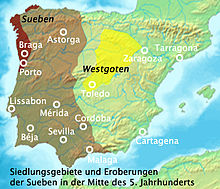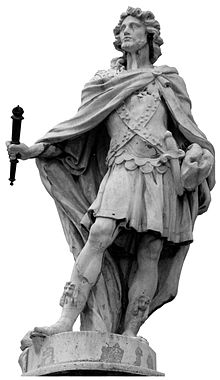Rechiar

Rechiar († December 456 ) was from 448 to 456 AD king or rex of the warrior association of the Suebi in Spanish Galicia - the Suebian Empire . The main contemporary source for Rechiar's life is the Chronicle of Hydatius .
Life
Rechiar was the son of the Suebian warlord Rechila . He was still a pagan, but Rechiar became a Catholic Christian before he ascended to the throne. This step was probably promoted by Roman missionaries, but the exact background for his change of religion is unknown. Most of his men remained pagans. He became the new rex of the Suebi after the death of his father (August 448) , but his inauguration was fraught with difficulties, as members of his family secretly resisted his assumption of power. In order to assert himself, he now carried out a large raid in imitation of his father.
In 449, Rechiar took an Arian Visigoth princess, the daughter of Theodoric I , as his wife . She contributed to the fact that the Suebi later adopted Arianism. The Catholic King Rechiar is therefore an exception.
In Gallaecia , which the Suebi had long since possessed and effectively ruled, the imperial government formally recognized them as foederati . Rechiar took advantage of the turmoil that Westrom had been exposed to for decades and acted skillfully in the power vacuum that had developed in Hispania. As a de facto independent ruler who expanded the Suebi’s sphere of influence the most, Rechiar , who resided in Bracara (now Braga ), had his own coins struck with the inscription iussu Richiari regis . Of these, three siliquae (light, late antique silver coins) survived , replicas of coins of Emperor Honorius . Since he was the current Western Roman government under Valentinian III. not recognized, he did not appoint any imperial officials in the administration.
In February 449, Rechiar invaded the Basque territory during a raid . Then he traveled to Gaul and paid a visit to Theodoric I there (July 449). When he returned, he devastated the area around the city of Caesaraugusta (today Saragossa ) in an alliance with rebellious Celto-Roman peasants, the Bagauden under their leader Basilius , and resorted to a ruse to conquer Ilerda (today Lleida ) to be able to. He took many prisoners but was unable to take the provincial capital, Tarragona . He does not seem to have participated in the attack of the Hun Attila on Gaul (451). Instead, he sought a compromise with the government in Ravenna and therefore acted with Emperor Valentinian III. 452 a new alliance treaty ( foedus ), which he confirmed after the death of the mighty army master Aëtius at the end of 454.
The peace between the Suebi and the Roman Empire ended after Valentinian III. was murdered (March 16, 455) and the vandal Geiseric attacked Rome shortly afterwards . The apparent weakening of the Western Roman government allegedly enticed Rechiar to conquer all of Spain and to make himself formally independent. So at the end of 455 he attacked Carthaginiensis, who had returned to the Romans during the earlier period of peace . The messengers sent by his brother-in-law, the Visigoth Theodoric II , and the new emperor Avitus were unsuccessful in their efforts to prevent the Suebi from further military action. Instead, he plundered the last province of Spain under effective Roman rule, the Tarraconensis .
On behalf of Avitus, the Visigoth foederati then moved with a strong contingent and together with Burgundians under their rex Gundioch to the Iberian Peninsula in order to subject the country again to the control of Ravenna. Rechiar wanted to repel the attack on the border of the Tarraconensis. He suffered a heavy defeat against Theodoric II on October 5, 456 at the Paramus campus on the small river Urbicus (today Órbico), 12 miles from Asturica (today Astorga ). He then conquered the Suebian metropolis Bracara (October 28, 456) and brutally pillaged them. According to Hydatius, Rechiar, injured in the battle near Asturica, sought his salvation by fleeing to Galicia; the historian Jordanes later reports that he tried to escape by sea but was driven back by adverse winds and captured. In any case, the arrest took place in Portus Cale (today Porto in Portugal). Rechiar was executed on the orders of Theodoric II in December 456.
The Suebi submitted to the Visigoths, but the association later regained its independence - albeit in a greatly weakened form - and continued to exist under its own active force until 585.
literature
- Pablo de la Cruz Díaz Martínez: Requiario , in: Diccionario biográfico español , Madrid 2009–2013, online version
- Stefan Krautschick : Rechiar. In: Reallexikon der Germanischen Altertumskunde (RGA). 2nd Edition. Volume 24, Walter de Gruyter, Berlin / New York 2003, ISBN 3-11-017575-4 , pp. 208-209. (on-line)
- Otto Seeck : Rechiarius. In: Paulys Realencyclopadie der classischen Antiquity Science (RE). Volume IA, 1, Stuttgart 1914, column 379.
Remarks
- ↑ For the various forms of name ( Reciarius , Richarius, etc.) see Seeck (see Lit.) Col. 379.
- ^ Hydatius , Chronik 137, in: Theodor Mommsen (Ed.): Auctores antiquissimi 11: Chronica minora saec. IV. V. VI. VII. (II). Berlin 1894, p. 25 ( Monumenta Germaniae Historica , digitized version )
- ^ Hydatius, Chronik 140, in: MGH AA 11, p. 25; Jordanes , De origine Getarum 44, 229.231; in: Theodor Mommsen (ed.): Auctores antiquissimi 5.1: Iordanis Romana et Getica. Berlin 1882, p. 116 ( Monumenta Germaniae Historica , digitized version )
- ↑ Hydatius, Chronik 140-142, in: MGH AA 11, p. 25.
- ↑ Hydatius, Chronik 155 and 161, in: MGH AA 11 p. 27.
- ↑ Jordanes, De origine Getarum 44, 229f.
- ^ Hydatius, Chronik 168, in: MGH AA 11, p. 28.
- ↑ Hydatius, Chronik 170 and 172, in: MGH AA 11, p. 28; see. Jordanes, De origine Getarum 44, 231
- ↑ Chronica Caesaraugusta , ad a. 458, in: Theodor Mommsen (Ed.): Auctores antiquissimi 11: Chronica minora saec. IV. V. VI. VII. (II). Berlin 1894, p. 222 ( Monumenta Germaniae Historica , digitized version )
- ↑ Hydatius, Chronik 172-175, in: MGH AA 11, p. 28f .; Jordanes, De origine Getarum 44, 232
| predecessor | Office | successor |
|---|---|---|
| Rechila |
King of the Suebi 448–456 |
Agiulf |
| personal data | |
|---|---|
| SURNAME | Rechiar |
| BRIEF DESCRIPTION | Suebi king |
| DATE OF BIRTH | 5th century |
| DATE OF DEATH | December 456 |
